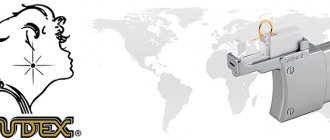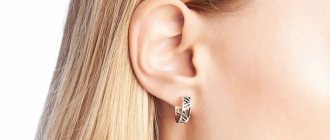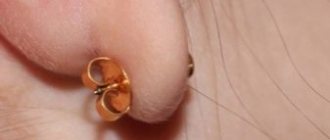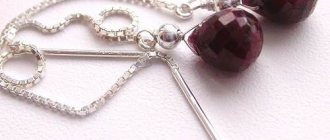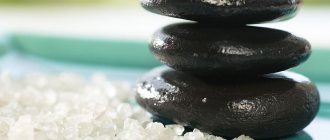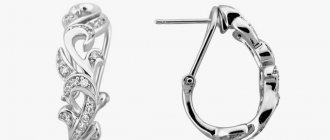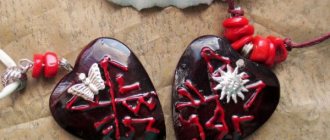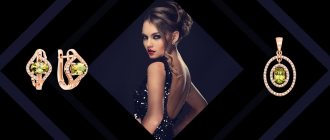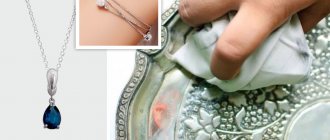Plan
- Types of ear cartilage piercings
- Which earring to choose?
- Stages of the procedure.
- What to do before piercing?
- Contraindications
- How does the process work?
- Caring for your piercing after the procedure
- What tools are used?
- How many days does it take to heal?
- Possible complications after piercing
- What problems might arise and why?
- Recommendations
- Range
- What's in fashion?
The history of ear cartilage piercing goes back centuries: before, every element of the image had meaning, now stylish hoop earrings are a beautiful, spectacular element of a holistic image. To obtain the result, a puncture is performed with a special instrument.
Interestingly, ear piercing is one of the oldest forms of body modification. This was done long before our era, which is confirmed by archaeological research. In the twentieth century, there was a real “boom” in piercing - regarding the piercing of the lobe, it was done by friends at each other’s homes. Gradually, this procedure is turning into a separate service from a medical specialist.
Cartilaginous piercing differs significantly from earlobe piercing - both in the procedure, the instruments used, the care, and the healing process. This type of puncture is painful and sometimes requires pain relief.
Helix
The puncture is located in the upper cartilage under the helix of the ear. At the moment, the most popular piercing, because in this place you can make several piercings at once, or put a cluster with cubic zirconia or opals, which will emphasize the shape of your ear and also attract attention to its owner. Helix requires careful handling during healing, as well as mandatory replacement of the primary jewelry to avoid distortion of the puncture.
Methods of ear piercing
There are several types of ear piercings.
Earlobe piercing is the most painless and common type of ear piercing. Recently, it has become fashionable to pierce the earlobe in several places at once.
You can pierce not only the earlobe, but also the cartilage: the upper part of the auricle is most often chosen for this.
Industrial piercings are usually done at the top of the ear and involve the creation of two parallel piercings connected by one piece of jewelry.
instagram.com/professional_piercing/
With day piercing, a through puncture is made in the cartilage of the auricle above the well. Having done such a piercing, be prepared for the fact that now you will have to approach the choice of headphones with special care.
instagram.com/dr_pierson/
Tragus piercing, or tragus piercing as it is also called, involves piercing the cartilage that protrudes from the center of the ear. One of the most painful types of piercing.
instagram.com/trine_morozova/
Anti-tragus - the puncture is carried out in the area just above the lobe.
Helix piercing is a piercing of the helix of the auricle. Not the most painful type of piercing, but characterized by a fairly long healing period, which lasts up to six months. Suitable for those who want to wear cuff earrings.
instagram.com/_nettattoo_/
Anti-helix is when the area just above the tragus is pierced. This, like most of the above types of piercing, is not recommended to be done independently and at home: this should be done by professionals using special equipment.
instagram.com/trine_morozova/
Ear piercing jewelry
Nowadays ear piercing jewelry can be chosen to suit every taste and color. They are made from different materials - silver, gold or medical steel, but they are not suitable for piercing due to the presence of nickel in the alloy, which oxidizes when worn; the highest quality and safest jewelry is made of titanium . It is the choice of material that determines how long an ear piercing will take to heal.
Stud earrings and studs have faded into the background; the most popular piercing jewelry has become labrets with wraps, microbananas, barbells, clickers or circulars , the size of which is selected individually for each person.
Often, ear piercings on top are decorated with clusters, which are arranged in the shape of the ear, and piercings inside the ear are decorated with clickers with cubic zirconia or opals.
What is a cartilage puncture called?
The picture was taken from one English-speaking site and the names do not change because they are all pronounced without translation, although words such as lobe (lobe) of course need to be translated
The most popular species in the CIS are:
- Tragus
- Helix
- Industrial
- Orbital
From the picture we can see complex punctures; you can identify them by touching your ear. For example, at the bend of the ear there is dense cartilage. And rook generally requires puncturing two cartilages at once, and besides, it’s difficult to get to them. Of course, an amateur cannot cope with this.
Care and healing
How carefully you take care of your piercing determines its healing and the risk of problems. Your ear piercer should advise you on how to treat your ear piercing after the procedure. Antiseptic sprays Miramistin and Octenisept are best suited , but it is better to avoid hydrogen peroxide, chlorhexidine and saline solution. Treatment of ear piercings should occur 2 times a day, and you should not use cotton swabs or cotton pads . Due to the risk of injuring the puncture with hair, masks, etc., it is necessary to cover the fresh wound with a soft-lined plaster for 2 weeks. If you nevertheless injured your puncture and it became inflamed, purchase Baneocin ointment , apply a thin layer 2 times a day, but use the ointment for no more than 5 days. If the inflammation does not go away, consult your specialist.
A fresh puncture should not be steamed for 2-4 weeks (baths, saunas, hot baths are prohibited), and swimming in open water bodies should also be avoided during this period. Do not turn the jewelry under any circumstances , as this will injure the puncture. If accumulations of dried blood and lymph have formed on the puncture, do not pick or pick at them.
puncture requires mandatory downsizing (replacing the primary labret with a shorter one) after 2-3 weeks, which is associated with migration of punctures in this place. In sebum piercings, downsizing is done at the request of the client. If the jewelry clings strongly and injures the canal, it is advisable to replace it to prevent injury.
Content
- At what age can you get your ears pierced?
- Is it harmful for a girl to pierce her ears too early?
- How does the time of year affect a child's ear piercing?
- How to prepare your ears for piercing
- How to speed up healing after ear piercing
- Where is the best place to get your ears pierced?
- How to pierce ears
- When should you not pierce your child's ears?
Earrings are one of the first jewelry that girls wear. Parents who want to pierce their little ones' ears are wondering where and when is the best time to do it, what is the best piercing method, and how to prepare? There is no consensus on when it is best to pierce a girl’s ears. Some do this as early as six months, while others last up to 5-6 years or more.
What do we need
First of all, we need a second pair of hands, which will gladly make a hole in us, or even two. You need to know how to hold the clamp yourself, make a puncture, and then insert the jewelry into the needle so that you don’t accidentally prick your finger.
Piercing needles, a disposable clamp and a bioplastic labret can be bought on Aliexpress
- Antibacterial soap
- Non-toxic marker
- Disposable gloves
- Saline solution
What earrings are needed?
This section is divided into two parts, secondary and primary decoration. You should have the first and second ones in advance to find out what diameter the needle should be.
Secondary jewelry is what you will wear after the piercing has completely healed and not before. You can choose any material to which you are not allergic.
Primary decoration
I recommend using bioplastic labret as it is one of the two approved materials for primary decoration.
Flexible cool, beautiful bioplastic
The second approved material is implantation titanium ASTF 136 , but if you are buying such a thing, it is advisable to see the documents for the product, since even ordinary surgical steel is passed off as it.
Why shouldn't you use surgical steel?
Because it contains a higher concentration of nickel. The permissible value is 0.05%, and in surgical 316L/LVM from 0.10% to 0.25%
You shouldn’t buy any metal jewelry on aliexpress as there is a possibility of getting poor quality and even the polishing on such products is not smooth, and this is super evil for us
Piercing with a gun or needle
The piercing needle is always in a sterile and sealed package, and also passes smoothly through the tissue (if you use a clamp)
The primary decoration and needle should be larger in diameter than the secondary decoration. For example, you have a primary decoration with a diameter of 18g, then the needle and primary decoration should be larger, therefore 16g
Can I use a disposable gun?
The fact is that the jewelry in the gun will never be as well polished as a needle, moreover, it is not so sharp which leads to the formation of a keloid during healing. The cartilage may also crack, and a bruise may simply appear due to the fact that the procedure is not carried out smoothly.
Clamp
Disposable Alik clamps are sold in sealed packaging and are immediately ready for use.
This is a very important device and helps to hold the victim tightly, otherwise at the sight of a needle they always strive to jump out of the window. But seriously, below you will see a photo with a bruise and this may be due to the fact that the clamp was not used.
When can you get your ears pierced?
If we are talking about the time of year, we wrote about it here. And yet, let us repeat that spring and autumn are the best times for piercing .
Health status
All this is done exclusively at the moment when you do not have such a question: “Is it possible if I don’t feel well?” You should be completely healthy and the first weeks of healing should go smoothly, or better yet the first couple of months.
Contraindications
There are not many of them, but they are there, and on this list, of course, are pregnancy and underage. If you have even the slightest suspicion that you shouldn’t do this, go to a therapist and he will advise you. They don’t charge money for a simple visit to him.
- Bleeding disorder
- predisposition to allergies
- otitis and other ear diseases
- mental disorders
- viral, infectious form of disease
You also cannot play sports, go to the pool or swim in other bodies of water.

